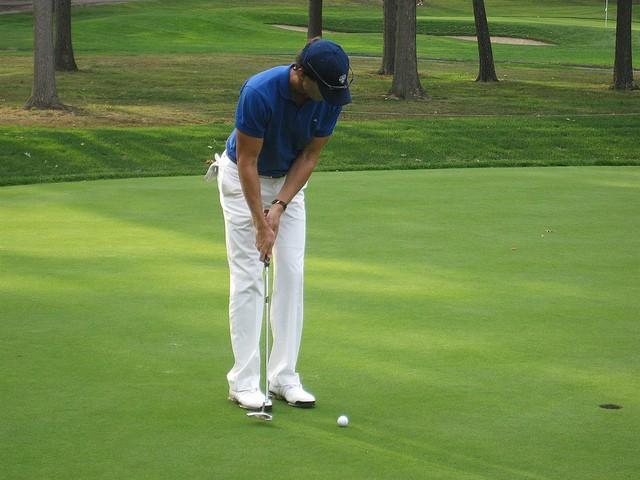Mastering Short Putts: Your Guide to Precision and Success
Short putts can be the decisive factor in a golfer’s performance, often determining the outcome of a match. To excel at these crucial shots, it’s essential to refine your putting mechanics to achieve peak performance.
In this comprehensive guide, we explore the fundamentals of putting precision, equipping you with techniques and insights necessary for mastering short putts. Learn from seasoned professionals as we dissect key elements such as grip pressure, stance stability, alignment, and video analysis.
With this knowledge at your disposal, you’ll be empowered to elevate your short game. Reduce inconsistencies, enhance reliability, and become the golfer you’ve always aspired to be.
– Understanding the Fundamentals of Short Putting
To truly master short putts, it’s vital to minimize unnecessary movements. Focus on executing a smooth pendulum-like stroke while avoiding excessive wrist or body motion. Ensure that your legs, hips, and head remain stable throughout the process; movement should primarily come from your arms and shoulders.
Establish a clear aim by selecting an appropriate target point—whether it’s the center or edge of the hole—and ensure that your club face is aligned perpendicularly with this line. This alignment will help maintain stability during your swing. Remember that pace is just as critical as accuracy; aim for a strike that sends the ball rolling about 12 inches past the hole—this reduces chances of lipping out or overshooting.
– Precision in Aiming: Selecting Your Target
When it comes to short distances on the green, precision is everything. The accuracy of your aim directly impacts how well you sink those crucial putts. Before addressing each shot, determine where you want to direct the ball—be it center or edge—and consider any slight breaks in play (short putts typically have minimal break).
Aligning your club face squarely with this chosen line ensures that its trajectory remains true throughout execution. Avoid overthinking potential breaks; instead focus on delivering enough force so that it rolls slightly beyond—around 12 inches past—the hole for optimal results.
– Achieving Harmony in Pace and Distance
Successfully navigating short putts hinges on finding an ideal balance between pace and distance control. By adopting a steady pendulum-like stroke devoid of excessive movement patterns, golfers can ensure their ball rolls smoothly toward its target.
For precise aiming during practice sessions or games alike choose points near or along the hole’s edge while steering clear from extreme break considerations due largely because they rarely apply within such close ranges! Square up properly before striking ensuring consistent delivery every time! Aim for sending balls approximately 12 inches beyond their intended destination using visual aids like alignment rods if needed! Mastery over these aspects significantly boosts one’s chances at sinking those pivotal shots!
| Pace Preference | Distance Beyond Hole |
|—|—|
| Soft | 6-12 inches |
| Medium | 9-15 inches |
| Firm | 12-18 inches |
– Perfecting Your Putting Routine for Consistency
Perfecting Your Putting Routine
A reliable putting routine is essential for enhancing accuracy while minimizing variability on greens. Here’s how you can establish an effective routine:
- Simplify Your Stroke: Focus on creating fluidity through arm-and-body coordination without involving wrists excessively which helps maintain consistency across strikes.
- Aim Thoughtfully: Visualize clearly where you’d like each shot directed without overstating potential breaks since they tend not matter much here!
- Pace Control: Strive towards hitting balls firmly enough so they roll roughly twelve additional feet past holes reducing risks associated with under-hitting!
An alignment rod positioned behind holes serves effectively when practicing lines/paces allowing greater confidence & consistency leading into successful rounds ahead!
Mastering Short Putts: Your Guide to Precision
By adhering closely principles outlined herein golfers stand poised transform their approach towards shorter games developing strokes characterized by both precision & reliability ultimately leading them closer victory across competitive matches.

Short Putts Made Simple: Elevate Your Game with Precision Techniques!
Understanding Short Putts
Short putts, generally defined as those within six feet of the hole, are critical in lowering your score. Understanding the mechanics behind them is essential;
- Grip Pressure: Maintain a light grip to avoid tension.
- Stance and Alignment: Keep a stable stance and align your body properly towards the hole.
- Pendulum Stroke: Use a simple, pendulum-like motion for consistency.
Key Mechanics for Short Putting
Mastering short putts involves refining these key mechanics:
1. Grip Technique
Ensure that your grip is firm yet relaxed. This allows for a delicate touch required for short putts.
2. Stance and Balance
Your feet should be shoulder-width apart, with your weight evenly distributed. This stability is crucial for a smooth stroke.
3. Alignment
Align your body and the putter face to the target line. Using a reference point can help maintain focus.
4. Pendulum Motion
Keep your elbows close to your body and generate a pendulum-like swing, minimizing extra movement for optimal control.
Practical Tips for Perfecting Short Putts
- Practice in Different Conditions: Vary your practice routine, including different slopes and grass types.
- Work on Your Pace: Practice rolling the ball the right distance; ideally, it should pass slightly beyond the hole.
- Visualization: Before each putt, visualize the ball’s path to the hole.
Benefits of Mastering Short Putts
- Lower Scores: Short putts can significantly impact your overall score.
- Increased Confidence: Successfully sinking short putts fosters confidence in your overall game.
- Improved Focus: Concentrating on technique enhances your mental game.
Case Studies: Successful Short Putters
| Player | Technique | Tips for Success |
|---|---|---|
| Ben Crenshaw | Pendulum Stroke | Practice with foot placement. |
| Phil Mickelson | Soft Touch | Visualize the path before each putt. |
| Annika Sörenstam | Consistent Grip | Keep the grip light and relaxed. |
First-Hand Experience: Tips from a Amature Golfer
As an amateur golfer, I struggled with short putts until I adopted a focused approach:
- Consistent practice helped reduce anxiety over short putts.
- I began keeping my head still during the stroke to enhance focus.
- Regularly assessing my grip pressure made a noticeable difference.
Conclusion
By honing your short putting skills through focused practice and understanding the key mechanics, you can significantly improve your precision and confidence on the green. Remember to stay patient and consistent in your training.





